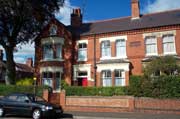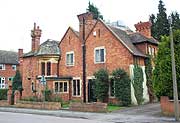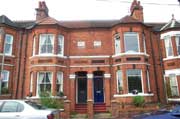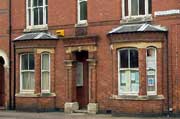|
|
|
A catalogue of Victorian and Edwardian workers’ housing
Within a very small area Wolverton possesses an almost complete range of types of Victorian and Edwardian workers’ housing arranged in a grid form in mainly two storey terraces within generously wide streets with backways having stone gutters down the centre. This layout was partly dictated by land constraints but was also a reflection of what was happening elsewhere in British industrial centres under the requirements of new Public Health Acts.
The earliest high density back to back houses built by the London & Birmingham and the LNWR Railway Companies pre Swindon have been demolished - the ‘Little Streets’ disappearing in the late 1960s - a victim of a post war ‘slum clearance’ rather than ‘regeneration’. The oldest houses that now survive within the Conservation Area were built in the 1860s: the majority were built in the late 19th century and the ‘youngest’ were completed by 1906.
After the First World War terrace house development was superseded by a fashion of private and public semi-detached housing as shown in the development to the south of the Conservation Area in Wolverton.
At first the Railway Companies built all of the housing but in 1878 the Wolverton Permanent Building Society was established with the encouragement of the LNWR Railway Company. Henceforward the housing needs of the town were to be met by private builders, the company negotiating the acquisition of the land and setting out the streets.
The interface between company and private housing can be seen in Church Street and in Buckingham Street. The north side of Buckingham St (even numbers) was built before 1878 by the company for their office clerks (according to the oldest resident) to a fine and unusual single design with elements derived from Gothic architecture, such as the nailhead decoration of the cornice, carried out in brick. The houses all originally had 16 pane box sash windows, which survive only at No.78. On the other side, the south side (odd numbers) a variety of different house designs can be seen, put up by various builders, not all at the same date.
The Railway Works had its own hierarchy - of management, office staff, foreman, skilled and semi-skilled craftsmen and labourers and that is reflected in the town’s housing. Some of the best early houses were built along the Stratford Road facing the Works. Senior managerial staff lived there. There is at present no evidence as to whether these plots were allotted by the Railway Company on the basis of occupation or were just sold to the highest bidder. Senior railway station and Works staff also lived in rented accommodation in the villas alongside the Grand Union Canal near the second station entrance (now the site of the Secret Garden). Then, as the town developed on the rising ground to the south, the ‘better’ houses in each new phase, occupied by those with higher status within the works (foremen and clerical staff for example) were those at the edges and on the highest level of the contour. There were building features that helped to individualise and distinguish privately built houses - terracotta architectural mouldings, encaustic tiled doorways and, more noticeably, bay windows.
In the first phase of private dwellings there are bay windows on the south side of Aylesbury Street, setting a trend that was developed in the post 1893 development of the Cambridge Street and Windsor Street where the houses had not only bay windows but also small front gardens that were fenced with elaborate railings.
Some of the most distinctive residences have been lost notably the canal side villas that housed the Stationmaster and senior Railway Works staff : the Gables, home to the Works Superintendent was demolished in the 1960’s and replaced with a multi-storey block of flats. There are however a number of fine properties remaining: St George’s Rectory, the Beeches and Viewsley in Western Road; the Elms No’s 1 and 2 Green Lane, built for Dr Harvey and designed by Edward Swinfen Harris; the large houses in Stratford Road in the same block as the Working Men’s Club; the larger houses in Moon Street including the Congregational Manse; the Methodist Manse in Church Street and diagonally opposite its ‘twin’, the ‘Library’ house on the corner of Church Street and Cambridge Street, built and occupied by Mr Robinson the local builder and decorated almost as a ‘show house’ with a range of terracotta moulded features
Within the town there is a rich but limited palate of materials that are used in Victorian and Edwardian workers’ housing:
- Welsh slate, both conventional rectangular and fish-scale;
- Red brick;
- Bath stone for dressings;
- Terracotta tile ridges and chimney pots;
- Sash windows with a wide variety of glazing patterns;
- Foot scrapers;
- Panelled and part-glazed front doors, some with stained glass;
- Terracotta architectural mouldings used for cornices and storey and sill bands and as isolated panels;
- Coloured and encaustic tiles and some mosaics for doorsteps;
- Engineering brick and tiled paths;
- Cast iron guttering and downpipes, some with decorative fixings
- Cast iron front railings and gates (although only one original domestic example survived the World War II scrap metal appeals)
|
|
|
One of the original Railway Co. houses, No 78 Buckingham St
|
|
|
|
Bay windows in Windsor St
|
 |
The Beeches in Western Road
|
 |
|
The Elms in Green Lane
|
 |
|
Houses in Moon St
|
 |
|
The front of the house on the corner of Cambridge St and Church St, formerly the house of the builder Mr Robinson
|
|
![]()
![]()